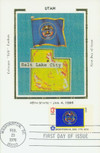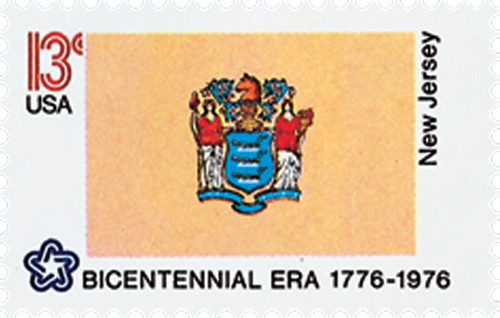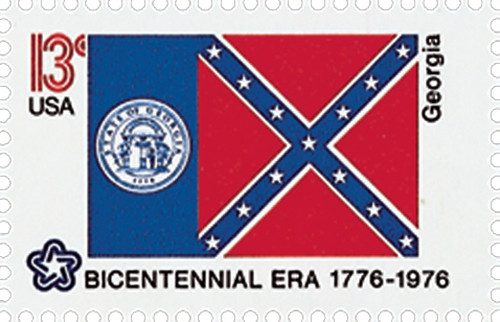
# 1677 - 1976 13c State Flags: Utah
U.S. 1677
1976 Utah
State Flags
American Bicentennial Series
• First time a sheet 50 had all different stamp designs
• Part of the American Bicentennial Series
Stamp Category: Commemorative
Series: American Bicentennial Series
Value: 13¢ First-class postage rate
First Day of Issue: February 23, 1976
First Day City(s): Washington, DC
Quantity Issued: 8,720,100 (panes of 50)
Printed by: Bureau of Engraving and Printing
Printing Method: Photogravure
Format: Sheet of 50
Perforations: 11
Why the stamp was issued:
The United States Postal Service celebrated the American Bicentennial with a full pane of the Union’s fifty state flags.
About the stamp design:
The symbols of Utah’s flag indicate the patriotism and work ethic of the original pioneers who made their homes there.
Mormon leader Brigham Young encouraged his followers to show allegiance to the United States by instructing them to unfurl the Stars and Stripes. Patriotism is still strong in Utah, and two U.S. flags and an American eagle are now featured on the state seal in the center of the flag.
Other aspects of the flag reflect Utah’s founding. The Latter-day Saints arrived in the unsettled southwest in 1847. They named the territory Deseret, meaning honeybee, according to the Book of Mormon. The beehive symbolized the ideals of hard work and self-reliance, which were needed to tame the harsh land.
The territory became the state of Utah in 1896. Though named for the Ute Indians, the Mormons beehive was incorporated into the state’s seal.
Utah was still without an official flag when the Sons and Daughters of Utah Pioneers presented a banner to the battleship USS Utah. It displayed the state seal, surrounded by a gold circle on a blue field. This flag was so well-liked, it became the official symbol of Utah in 1913.
About the printing process:
Printed by the Bureau of Engraving and Printing on their seven-color Andreotti gravure press (601) which was their work horse for multicolored stamps.
About the American Bicentennial Series:
In the 1970s, America celebrated its 200th anniversary with hundreds of national events commemorating the heroes and historic events that led to our nation’s independence from Great Britain. The U.S. Postal Service issued 113 commemorative stamps over a six-year period in honor of the U.S. bicentennial, beginning with the American Revolution Bicentennial Commission Emblem stamp (U.S. #1432). As a group, the Bicentennial Series chronicles one of our nation’s most important chapters, and remembers the events and patriots who made the U.S. a world model for liberty.
Several of the stamps honored colonial life – craftsmen and communication. Other stamps honored important battles including Lexington and Concord, Bunker Hill, and Saratoga. Significant events such as the Boston Tea Party, the meeting of the First Continental Congress, and the Declaration of Independence were featured as well. The stamps also honored many significant people such as George Washington, Sybil Ludington, Salem Poor, and the Marquis de Lafayette.
Many of the stamps feature classic artwork. For instance, the set of four souvenir sheets picture important events recreated by noted artists such as John Trumbull. The Bicentennial Series also includes an important US postal first – the first 50-stamp se-tenant – featuring all 50 state flags. The format proved to be popular with collectors, and has been repeated many times since.
The American Bicentennial Series is packed with important US history – it tells the story of our nation’s fight for independence through stamps.
History the stamp represents:
Utah achieved statehood on January 4, 1896.
After 17 months of travel searching for a new home for his persecuted people, Brigham Young found Utah’s Great Salt Lake Valley on July 24, 1847 and proclaimed, This is the place (as pictured on U.S. #950).
The Church of Jesus Christ of Latter-day Saints was founded in 1830 when Joseph Smith published the Book of Mormon. The religion grew fast in his New York Community and spread to Ohio, Missouri, and Illinois. However, it included controversial practices, including polygamy, which made its followers targets of mob violence.
Following Smith’s death, Brigham Young became the church’s new leader and vowed to find a new home for all of his fellow Mormons, in a place on this earth that nobody else wants. He led a convoy of more than 10,000 followers and set up camp in Iowa. Young then took a smaller detachment of 148 people across the Rocky Mountains. As soon as he reached Utah’s Great Salt Lake Valley, he knew it was his people’s future home.
These devout settlers called the region Deseret, after the Mormon word for honeybee. The honeybee is an important symbol of hard work and industry for the Mormons. Many people still refer to Utah as Deseret, and Utah’s nickname is the Beehive State.
In 1849, the Mormons established the Perpetual Emigrating Fund. This fund helped Mormons move to Utah. It operated for about 40 years and attracted about 50,000 Mormons to Utah. These people came from other areas of the United States as well as Denmark, England, Norway, Scotland, Sweden, and Wales.
When the Mormons first arrived in Utah, the area officially belonged to Mexico. However, at that time the U.S. and Mexico were fighting the Mexican War, which lasted from 1846-1848. When the U.S. won the war, it acquired a great deal of land, including Utah.
The Mormons established the State of Deseret in 1849, with a temporary government led by Brigham Young. A constitution was adopted, and the settlers asked to be admitted to the Union. However, Congress was embroiled in great debates about slavery at the time. But with the Compromise of 1850, the Utah Territory was established.
Between 1849 and 1895, Utah tried to join the Union several times. Congress refused because of an uncommon Mormon practice called polygamy specifically, a form where a man had more than one wife which they referred to as plural marriage. Few Mormons actually practiced polygamy. But as long as the Mormons allowed it, Utah was denied statehood.
The Federal government began enforcing the laws against polygamy during the 1880s. About 1,000 Mormons were fined or sent to prison. In 1887, a law was passed allowing the Federal government to seize church property for use by public schools. In 1890, the church began discouraging polygamy, and by 1904 it was prohibited.
In 1895, Utah submitted a new constitution to Congress. This constitution outlawed polygamy and protected the government from church domination. As a result, Utah achieved statehood on January 4, 1896.
U.S. 1677
1976 Utah
State Flags
American Bicentennial Series
• First time a sheet 50 had all different stamp designs
• Part of the American Bicentennial Series
Stamp Category: Commemorative
Series: American Bicentennial Series
Value: 13¢ First-class postage rate
First Day of Issue: February 23, 1976
First Day City(s): Washington, DC
Quantity Issued: 8,720,100 (panes of 50)
Printed by: Bureau of Engraving and Printing
Printing Method: Photogravure
Format: Sheet of 50
Perforations: 11
Why the stamp was issued:
The United States Postal Service celebrated the American Bicentennial with a full pane of the Union’s fifty state flags.
About the stamp design:
The symbols of Utah’s flag indicate the patriotism and work ethic of the original pioneers who made their homes there.
Mormon leader Brigham Young encouraged his followers to show allegiance to the United States by instructing them to unfurl the Stars and Stripes. Patriotism is still strong in Utah, and two U.S. flags and an American eagle are now featured on the state seal in the center of the flag.
Other aspects of the flag reflect Utah’s founding. The Latter-day Saints arrived in the unsettled southwest in 1847. They named the territory Deseret, meaning honeybee, according to the Book of Mormon. The beehive symbolized the ideals of hard work and self-reliance, which were needed to tame the harsh land.
The territory became the state of Utah in 1896. Though named for the Ute Indians, the Mormons beehive was incorporated into the state’s seal.
Utah was still without an official flag when the Sons and Daughters of Utah Pioneers presented a banner to the battleship USS Utah. It displayed the state seal, surrounded by a gold circle on a blue field. This flag was so well-liked, it became the official symbol of Utah in 1913.
About the printing process:
Printed by the Bureau of Engraving and Printing on their seven-color Andreotti gravure press (601) which was their work horse for multicolored stamps.
About the American Bicentennial Series:
In the 1970s, America celebrated its 200th anniversary with hundreds of national events commemorating the heroes and historic events that led to our nation’s independence from Great Britain. The U.S. Postal Service issued 113 commemorative stamps over a six-year period in honor of the U.S. bicentennial, beginning with the American Revolution Bicentennial Commission Emblem stamp (U.S. #1432). As a group, the Bicentennial Series chronicles one of our nation’s most important chapters, and remembers the events and patriots who made the U.S. a world model for liberty.
Several of the stamps honored colonial life – craftsmen and communication. Other stamps honored important battles including Lexington and Concord, Bunker Hill, and Saratoga. Significant events such as the Boston Tea Party, the meeting of the First Continental Congress, and the Declaration of Independence were featured as well. The stamps also honored many significant people such as George Washington, Sybil Ludington, Salem Poor, and the Marquis de Lafayette.
Many of the stamps feature classic artwork. For instance, the set of four souvenir sheets picture important events recreated by noted artists such as John Trumbull. The Bicentennial Series also includes an important US postal first – the first 50-stamp se-tenant – featuring all 50 state flags. The format proved to be popular with collectors, and has been repeated many times since.
The American Bicentennial Series is packed with important US history – it tells the story of our nation’s fight for independence through stamps.
History the stamp represents:
Utah achieved statehood on January 4, 1896.
After 17 months of travel searching for a new home for his persecuted people, Brigham Young found Utah’s Great Salt Lake Valley on July 24, 1847 and proclaimed, This is the place (as pictured on U.S. #950).
The Church of Jesus Christ of Latter-day Saints was founded in 1830 when Joseph Smith published the Book of Mormon. The religion grew fast in his New York Community and spread to Ohio, Missouri, and Illinois. However, it included controversial practices, including polygamy, which made its followers targets of mob violence.
Following Smith’s death, Brigham Young became the church’s new leader and vowed to find a new home for all of his fellow Mormons, in a place on this earth that nobody else wants. He led a convoy of more than 10,000 followers and set up camp in Iowa. Young then took a smaller detachment of 148 people across the Rocky Mountains. As soon as he reached Utah’s Great Salt Lake Valley, he knew it was his people’s future home.
These devout settlers called the region Deseret, after the Mormon word for honeybee. The honeybee is an important symbol of hard work and industry for the Mormons. Many people still refer to Utah as Deseret, and Utah’s nickname is the Beehive State.
In 1849, the Mormons established the Perpetual Emigrating Fund. This fund helped Mormons move to Utah. It operated for about 40 years and attracted about 50,000 Mormons to Utah. These people came from other areas of the United States as well as Denmark, England, Norway, Scotland, Sweden, and Wales.
When the Mormons first arrived in Utah, the area officially belonged to Mexico. However, at that time the U.S. and Mexico were fighting the Mexican War, which lasted from 1846-1848. When the U.S. won the war, it acquired a great deal of land, including Utah.
The Mormons established the State of Deseret in 1849, with a temporary government led by Brigham Young. A constitution was adopted, and the settlers asked to be admitted to the Union. However, Congress was embroiled in great debates about slavery at the time. But with the Compromise of 1850, the Utah Territory was established.
Between 1849 and 1895, Utah tried to join the Union several times. Congress refused because of an uncommon Mormon practice called polygamy specifically, a form where a man had more than one wife which they referred to as plural marriage. Few Mormons actually practiced polygamy. But as long as the Mormons allowed it, Utah was denied statehood.
The Federal government began enforcing the laws against polygamy during the 1880s. About 1,000 Mormons were fined or sent to prison. In 1887, a law was passed allowing the Federal government to seize church property for use by public schools. In 1890, the church began discouraging polygamy, and by 1904 it was prohibited.
In 1895, Utah submitted a new constitution to Congress. This constitution outlawed polygamy and protected the government from church domination. As a result, Utah achieved statehood on January 4, 1896.


















